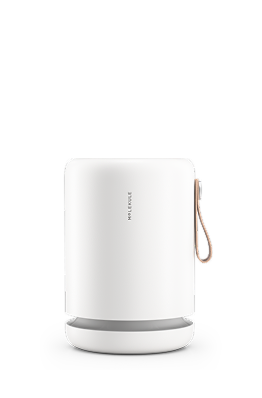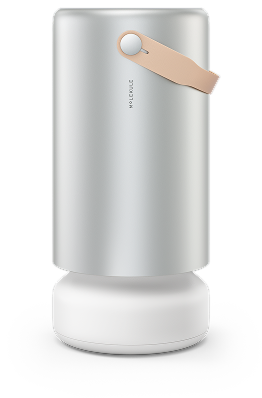Taking care of our air quality reduces a huge burden on our bodies. Each particle of smoke or molecule of nitrogen dioxide that your body has to spend time dealing with is less time to solve problems that lead to disease. As we age exposure to air pollution can lead to dementia, diabetes, and many forms of cancer.
The impact is even more drastic during fetal development, when the body is not just solving problems but also growing structures to use for the rest of its life. Air pollution can damage the DNA of a baby before they are born and is linked with lower birth weight, smaller heads, behavioral problems and a higher vulnerability to cancer and autoimmune diseases.
To reduce the risk we can look at real-time maps of outdoor air pollution like the AQI from the EPA or from services like PurpleAir. They provide a lot of information but it can be difficult to tell how it applies to each of us or what we plan to do on a particular day. Then a larger issue is that we spend most of our time indoors where indoor activities like cooking or cleaning have a bigger impact than outdoor air pollution. We have to buy and install our own air quality monitors to have an objective understanding of what we are breathing.
However, there are a few simple things to remember that aren’t too complicated in order to avoid a lot of air quality problems. When we are indoors, measuring carbon dioxide (or CO2) levels is a great way to know when things have gone wrong. When we are outdoors we can look at the AQI but understand that going outside for a little exercise is very healthy and when under about an hour usually outweighs the negative from air quality.
Air Pollutants Flock Together
Remembering what size particle is most unhealthy or the relative hazard of what concentration of what airborne chemical is really challenging, and only atmospheric chemists are truly aware of how they all interact with each other. But one actually useful aspect of air quality is that of all the different pollutants, most of them happen at the same time and build up in the same places. Indoors this is due to stale air, and outdoors due to the fact that fossil fuel combustion is the biggest contributor and fossil fuel smoke has both particle and gaseous air pollution.
The simplest method to determine how air quality is impacting your health is to look at one number. Indoors, look at carbon dioxide or CO2, and outdoors look at the AQI. Below we will discuss why.
CO2 for Indoor Air
Everyone is familiar with our friend CO2, which is inhaled by plants and exhaled by us or another organism. We all exhale CO2 constantly so it needs to be removed from indoor spaces. One massive study on hundreds of people across the world found indoor CO2 levels to be a good indicator of both particle pollution and poor cognitive performance. Lack of oxygen isn’t actually the biggest problem in a stuffy room, it’s extra CO2 causing the biggest problems.
More importantly, high indoor CO2 only happens in poorly ventilated spaces where breathing (or fire) is going on, and good ventilation can solve most indoor air quality problems. The detectors are also relatively inexpensive ($15-$25).
The Ideal Carbon Dioxide Level
One study in France looked at the correlation between CO2 and different chemicals and particles. The authors felt that the safest level of CO2 is around 660 ppm, though some pollutants didn’t build up to bad levels before 890 ppm CO2. Your brain’s ability to make decisions is impacted by CO2 levels over about 1,000 ppm, and safe workplace standards cap CO2 exposure at 3,000 ppm for an 8-hour day.
These levels aren’t all that high, the outdoor concentration is currently about 410 ppm, and near roads is closer to 550 ppm. In office buildings it can easily get up to 950 ppm and in poorly ventilated schools 1,400 ppm.
CO2 and most of the pollutants that have built up along with it can be removed very quickly with ventilation and you’ll see the ppm numbers drop off the monitor. Opening the window for seven minutes can replace half the air in a room, venting any and all air pollutants that have built up.

Keep in mind that using CO2 to measure air quality runs the risk of a false negative, or missing bad air quality when CO2 levels are not too high. Allergies from mold, pollen or pets, for example, will probably still trigger when CO2 is normal. A false positive, or when CO2 is high but air quality is good, is impossible because CO2 is a toxic gas itself, so high CO2 always means bad air quality and you can’t go wrong opening the window.
Air purifiers are great for reducing the pollution burden in areas with high CO2, but no air purifier currently available can remove CO2 at an effective rate. Plants are really the best at CO2 removal, with some estimates at 1400 plants. Most plants have day and night cycles according to how much light they get, so they would be split between a day and a night shift of 700 plants each.
Ideal Outdoor AQI
The World Health Organization issued a blanket statement last year that 99% of people live in areas with air quality that exceeds their recommended particle levels. This is alarming but hardly helpful because everyone can’t move to the 1% of inhabited areas that have decent air. The EPA here in the US also has recommendations for air quality using their Air Quality Index, which are less stringent than the WHO but also a little vague in the recommendations.
Though the EPA monitors five pollutants with the AQI, the number shown will only be for the worst pollutant at the time, and represents risk over 8 hours of exposure. For the most part, fine particles or PM2.5 tend to dominate the AQI in urban areas, so if the AQI is not available PM2.5 is the best substitute. For PM2.5, the EPA’s AQI is correlated to the micrograms per cubic meter (ug/m3) across the whole range of both, but the AQI rises four times faster at low levels of particles because the different between a little bit of pollution and no pollution is bigger for people who are particularly sensitive like the very old, very young, or with a history of pulmonary disease.

The recommendations from the EPA are somewhat vague for the average person. It’s not clear what the difference is between “should consider reducing exertion” and “should avoid prolonged exertion” or if they mean to reduce by half or all or some other amount. Also, exercise is extremely healthy so it’s not clear where the break-even point is.

There are two key facts to consider here. One is that the AQI represents an 8-hour exposure risk, so shorter times involve less risk. The other is that 30 minutes of exercise offers at least 90% of the benefits, and much more than 60 minutes offers very diminished returns.
One study broke it down like this for biking versus walking in different AQIs. 30 minutes of outdoor activity is pretty much always good for you, regardless of the AQI. Walking for up to an hour is generally very healthy for all AQIs, as well. You’ll want to pay attention for long bike rides, because once the AQI is orange, much more than an hour is not healthy. For other activities, consider if the effort is more comparable to sustained walking or sustained biking to get an idea of how the risk changes with exposure and with AQI.

Here is a graph of AQI and the duration of activity that is impactful on our health. Half an hour in any AQI isn’t likely to be harmful, and until the AQI is well over 150 (orange) walking is always a healthy activity. Where we might want to pay attention is where biking, or medium to heavy exertion, goes from generally healthy to just outweighing the negative impact of air pollution. After 100 AQI, it’s a good idea to cap bike rides at 2 or 3 hours and if the AQI is 150 or above just an hour or less of biking is best. Those of us who have the option to commute via bike should probably pay close attention to the AQI because when it’s over 200 more than 90 minutes of biking can be harmful.







